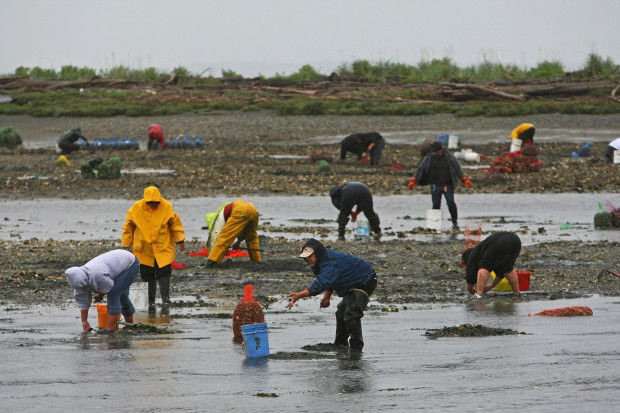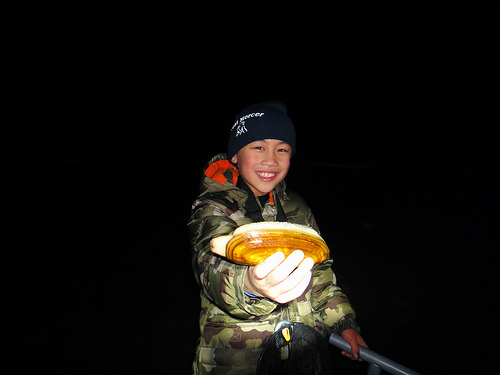Winter shellfish gathering garners attention in Hood Canal and Puget Sound albeit best tides happen at night 1

Here’s some outdoors news you can dig into to get you out of the winter doldrums.
While many shellfish enthusiasts have their thoughts on digging up a batch of coastal razor clams, there is are plenty of other shellfish worth the time and effort within a short drive from the greater Seattle area.
Unlike spring and summer shellfish gathering those that occur in the winter will happen in the dark of night since low tides occur during that time frame.
That means the most essential part of your gear isn’t just some warm clothes and rain gear to wick away the wetness, but a strong lantern coupled with a flashlight and headlamp.
Finding public access on beaches in Puget Sound and Hood Canal are relatively easy and the good news is you’ll likely find some solitude and a nice bucket of clams to boot.
Before heading to a beach be sure to check the WDFW and Department of Health websites for any closures or changes. Also keep in mind that all eastern mainland beaches from Everett south into southern Puget Sound are also closed for shellfish due to unsafe pollution levels.
Here is a rundown of places you can check out that should have you bring some fresh steamer clams and oysters to the dining table.
In the northern reaches, Birch Bay State Park in Whatcom County – open year-round for shellfish – has an enhanced oyster beach and is also good for Manila and littleneck clams.
Drayton West in Whatcom County is open year-round and is a productive place for Manila, native littleneck clams and butter clams and the best digging location is near the north end of Drayton West. A reminder that the adjacent beach to the north is Semiahoo Marina and it is closed year-round due to pollution.
Shine Tidelands State park in Jefferson County is an excellent location for Manila, littlenecks and butter clams. Manila littleneck clams can be found over most of the beach in the mid-high intertidal zone and Shine receives a decent plant of Manila clams. You can also have very good digging near the midpoint of the tidelands in the narrow band of sand/gravel that occurs fairly high on the beach.
Belfair State Park located about three miles west of Belfair in Mason County is an excellent oyster gathering spot, but the clams aren’t abundant.
In Hood Canal, Dosewallips State Park is excellent choice for oysters and Manila littleneck clams in the mid-upper tidal zone in mixed sand and gravel substrate and butter clams, cockles and horse clams can be found in the sandy areas below the oysters.
Eagle Creek near Lilliwaup off Highway 101 is solely and oyster gathering location as the clam digging is closed – except for a small window period in July – due to a low population. Point Whitney Lagoon and Tidelands are both ideal spots for a mix of clams and oysters.
Port Gamble Tidelands in Kitsap County supports a good number of Manila clams, native littleneck clams, butter clams, horse clams and eastern soft-shell clams (be aware of broken glass when digging and north end is great for historical glass for beach combers) and also has good patches of oyster beds.
Wolfe Property State Park north of Hood Canal Bridge there is an enhanced beach for clams and oysters with good numbers of native littleneck clams and Manila littleneck clams and some of the best clam digging is right in front of the access trail at the end of Seven Sisters Road and butter clams are found in the lower intertidal zone and is an excellent beach for oysters and receives regular oyster seeding with aid from natural production.
Other beaches in Hood Canal worth a try are Quilcene Bay Tidelands best known for Manila clam digging; Triton Cove for oysters only; Twanoh State Park for oysters only, and best spot is the west end of the park beach near the boat ramp in the “day use” portion of the park; and West Dewatto is a small beach for oysters only.
Upcoming low tides: Jan. 17, minus-0.6 feet at 7:44 p.m.; Jan. 18, -1.6 at 8:30 p.m.; Jan. 19, -2.5 at 9:17 p.m.; Jan. 20, -2.9 at 10:03 p.m.; Jan. 21, -3.0 at 10:50 p.m.; Jan. 22, -2.7 at 11:37 p.m.; Jan. 24, -1.8 at 12:24 a.m.; and Jan. 25, -0.5 at 1:11 a.m.
Other low tidal series coming up occur during the period of Jan. 31-Feb. 5; and Feb. 15-22. For day-by-day tides, go to http://www.saltwatertides.com/dynamic.dir/washingtonsites.html.
Remember to follow all the shellfish rules, daily limits, and gathering etiquette such as fill-in all holes, shuck all oysters and leave the shells on the beach where you found them.
A good reference for beaches open and/or closed can be found on the WDFW at
https://wdfw.wa.gov/fishing/shellfish/beaches/2019_ps_clam_oyster_seasons.pdf. WDFW also has a great interactive shellfish map at http://wdfw.wa.gov/fish/shelfish/beachreg.
Also for any emergency closures, call the marine biotoxin hotline at 800-562-5632 or visit the DOH website at www.doh.wa.gov Be sure to check the state fisheries hotline at 866-880-5431 and website at http://wdfw.wa.gov
All shellfish gatherers age 16 to 69 must have a valid state-issued shellfish/seaweed harvesting license. A Discover Pass is required for parking in Washington State Parks and at undeveloped state park lands. Go to www.discoverpass.wa.gov.
Recent coastal razor clam digs mostly a bust

The most recent coastal razor clam digs Jan. 2-6 were filled with good days and bad ones related to extremely rough surf and rainy conditions.
“Pretty light crowds given conditions and really only the very first night (Jan.2) at Twin Harbors was halfway successful,” said Dan Ayres, the head WDFW coastal shellfish manager. “The very last night (Jan. 6) at Mocrocks was good, but it never really picked up at Twin Harbors due to (less than ideal surf and weather conditions). In all 5,600 diggers (coast wide) averaged 7.5 clams per person.”
Ayres says they could get approval on the next series of digs as soon as Wednesday, Jan. 9. He didn’t expect any hang ups with marine toxins as the ocean is a big washing machine so things get pretty stirred up at this time of the year that includes digs at Kalaloch and they occur during the Martin Luther King holiday period.
Next proposed digs are: Jan. 17, low tide is 3:39 p.m., plus-0.4 feet at Twin Harbors; Jan. 18, 4:30 p.m. is minus-0.4 at Twin Harbors; Jan. 19, 5:18 p.m. is -1.1 at Twin Harbors, Mocrocks and Kalaloch; Jan. 20, 6:05 p.m. is -1.6 at Twin Harbors, Copalis and Kalaloch; and Jan. 21, 6:51 p.m. is -1.8 at Twin Harbors, Mocrocks and Kalaloch.
More proposed dates are: Feb. 1, 4:48 p.m. is 0.2 at Twin Harbors and Copalis; Feb. 2, 5:28 p.m. is 0.0 at Twin Harbors and Mocrocks; Feb. 3, 6:04 p.m. is -0.1 at Twin Harbors and Copalis; Feb. 15, 3:11 p.m. is 0.4 at Twin Harbors and Mocrocks; Feb. 16, 4:08 p.m. is -0.3 at Twin Harbors, Copalis and Kalaloch; Feb. 17, 4:59 p.m. is -1.0 at Twin Harbors, Copalis, Mocrocks and Kalaloch; Feb. 18, 5:46 p.m. is -1.4 at Twin Harbors, Mocrocks and Kalaloch; Feb. 19, 6:31 p.m. is -1.5 at Twin Harbors; Feb. 20, 7:14 p.m. is -1.3 at Twin Harbors; and Feb. 21, 7:56 p.m. is -0.8 at Twin Harbors.


State Parks says Shine Tidelands is closed at dusk. Are other beaches you recommend also in this category?